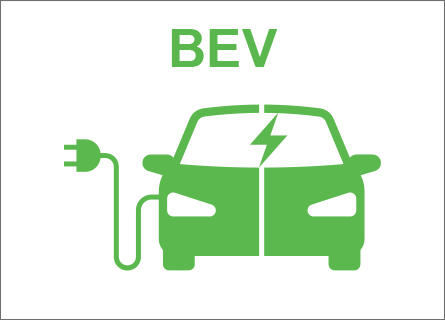Find the Right EV for You
As new battery electric and plug-in hybrid models become available on the EV market, you have multiple types of electric vehicles to choose from.


Battery Electric Vehicle (BEV)
-
Powered solely by electricity; does not have an internal combustion engine.
- Recharges through at-home and public charging stations.
- No tailpipe emissions or use of fossil fuels.

Plug-in Hybrid Electric Vehicle (PHEV)
- Powered by electricity and gas; has an internal combustion engine.
- Runs for a set number of miles on an electric battery; switches to gas when battery power runs out.
- Recharges through at-home and public charging stations.
- No tailpipe emissions or use of fossil fuels while the EV runs on electric battery power.
Shop EVs
Check out our online shopping tool that simplifies the EV shopping experience. Compare options for EV models, pricing, rebates, incentives and charging all in one place.
First, calculate how many miles you typically drive every day. While a battery electric vehicle (BEV) will likely fit your needs, a plug-in hybrid electric vehicle (PHEV) may be a better choice if you regularly drive longer distances. Use PlugStar to shop for new or used EVs.
Second, compare your EV charging options. EVs can charge at home with a standard, 120-volt charging station (Level 1 charger) that plugs in to a standard wall outlet. If you prefer a faster home charger, you can work with a certified electrician to install a specialized, 240-volt charging station (Level 2 charger). If you need to charge while on the road, DC fast chargers and Level 2 chargers are available at public charging stations.
Finally, explore various incentives, including tax credits and rebates, that may be available for the EV you want to purchase or lease.
The most regular maintenance you can expect with an EV is tire and windshield wiper replacement. Typically, an EV requires less maintenance than standard gasoline vehicles for the following reasons:
- An EV’s battery, motor and electronics require little to no regular maintenance.
- An EV has fewer moving parts and fluids that require regular maintenance.
- A plug-in hybrid EV requires fewer oil changes than gas vehicles, while a fully electric battery EV requires no oil changes at all.
- Due to regenerative braking, an EV’s braking system wears out less quickly than a gas vehicle’s conventional braking system.
Plug-in hybrid EVs require less gas than a standard gasoline vehicle, while battery EVs use no gas at all. When you charge and drive an EV instead of a gas vehicle, you significantly reduce your greenhouse gas emissions. Plus, if you have a solar energy system at your home, you drive with an almost net-zero environmental impact.
EVs deliver quicker acceleration than standard gasoline vehicles. They also have better handling than gas vehicles because they have a lower center of gravity and an almost ideal weight distribution.
The financial benefits of an EV include the following:
- Lower operational costs — The estimated cost of electricity to charge a plug-in EV is less than the average cost of gasoline to fuel a standard vehicle.
- Lower maintenance costs — An EV has fewer moving parts than a gas vehicle, so it requires little to no regular maintenance.
- Available rebates and tax credits — There are several state, federal and income-qualifying incentives that may help you save thousands on a new or used EV.
Want to Save on Your EV?
Compare incentives and rebates that help reduce the cost of buying or leasing an EV.




